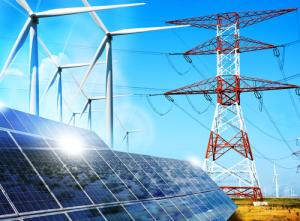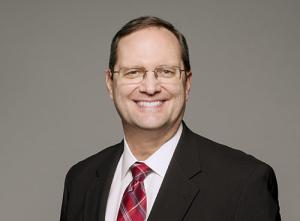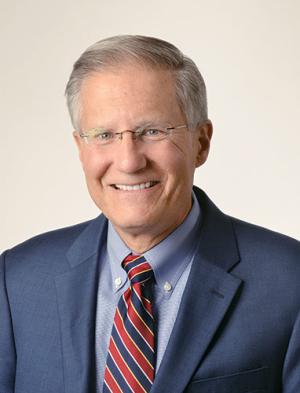Decarbonization
Steve Jackson is the COO of MEAG Power. Bob Yeager is president of power & water solutions at Emerson.
The road to decarbonization is on the mind of leadership in the energy and utilities industry. Strategies for getting there depend often on the starting point, as the legacy power business goes through transition.

MEAG Power is a public power joint action agency on a fascinating journey, as it provides wholesale electric power to forty-nine communities in Georgia. It is powered by diverse resources too, hydropower, nuclear, natural gas, coal, and lots of solar coming. MEAG Power is accompanied by Emerson, a global technology and engineering company that helps improve plant operations.
PUF talked with two leaders, MEAG Power COO Steve Jackson and Emerson president of power & water solutions Bob Yeager, about how to move forward with integration of renewables. Enjoy this in-depth conversation.
PUF's Steve Mitnick: What are the main challenges in the transition to net zero?
Steve Jackson: As we look at the transition to lower and, eventually, net-zero emissions, economically meeting power supply needs as we make this transition is important. At the same time, we expect increasing demand due to electrification.
 Steve Jackson: We can get to 85 or 90% of our supply being non-emitting but getting that last 10 to 15% is extremely expensive with available technology. If the technology improves rapidly for long-discharge batteries, hydrogen infrastructure, and flexible small nuclear units, these could be game-changers.
Steve Jackson: We can get to 85 or 90% of our supply being non-emitting but getting that last 10 to 15% is extremely expensive with available technology. If the technology improves rapidly for long-discharge batteries, hydrogen infrastructure, and flexible small nuclear units, these could be game-changers.
So, not only are you dealing with replacing higher-emitting with lower-emitting resources, but you also are dealing with building your portfolio to meet increasing demand. Making sure we can do that in a reliable and economic way is the mission of our company.
Making that transition economically while ensuring grid reliability is likewise important. This puts the focus on maintaining dispatchable resources on the system.
That's where we see natural gas being an important resource during this transition. It meets the multiple needs we have during this time before technology catches up with policy.
Policy has gotten ahead of the technology. Some people call natural gas a bridge resource. However you view it, being able to maintain the flexibility in the system as you add more wind and solar, non-dispatchable resources, is important. In addition, natural gas is a low-emissions resource. The result is the ability to maintain reliability, economics and a lower environmental profile.
 Bob Yeager: A good strategy for maintaining inherent reliability in the power system is to increase the reliability of plant operations. This can be accomplished by winterization, modernization and dependable black start capability, all supported by robust plant controls.
Bob Yeager: A good strategy for maintaining inherent reliability in the power system is to increase the reliability of plant operations. This can be accomplished by winterization, modernization and dependable black start capability, all supported by robust plant controls.
Also, as we retire existing generation resources, particularly coal, we must replan and rebuild the grid. Many of these retiring facilities are central to the grid operation, and we need to update the grid to operate with a new set of resources.
Electric utilities have to deliver when we are called upon. This obligation to serve needs to remain the focus for us in the future. As the industry changes and we address many competing goals, there cannot be any confusion on the importance of electric power and where the responsibility for that supply lies.
Bob Yeager: I like to categorize our industry's challenges by what I call the three Ds: decarbonization, decentralization, and digital transformation. There's a lot of pressure, not only in the U.S. but globally, to decarbonize or transition to renewables, which affects our electric infrastructures.
The U.S. has reduced the use of coal from about half of the generated capacity down to around twenty percent. That's good news for gas, which is about forty percent of capacity, and for renewables, which have gone up to about twenty percent.
Regulatory and environmental pressures are having a big impact on utilities' portfolios. You can't just quickly shut down power plants because that requires a lot of capital expense and planning to maintain affordable capacity and grid stability.
For example, we can't discount the importance of inertia. Inertia is created by heavy rotating equipment that instantaneously changes electric mechanical energy into electrical energy. It has a great dampening effect on the grid and helps to maintain the reliability and stability of the power system.
Over time, we can replace these effects on the grid with frequency responses from renewable resources combined with energy storage. But now, the variability of renewable generation drives the need for increased energy storage and faster ramping of traditional resources.
You can't ask the sun to shine more or the wind to blow faster, but you can increase the speed at which traditional resources respond to demand or you can add utility-scale energy storage to balance supply and demand. Bidirectional electricity flow from the addition of more decentralized renewable, distributed assets or microgrids onto the grid complicates things even more.
In response, we're seeing the emergence of virtual power plants, a group of smaller generators such as wind, solar, gas turbines or demand response programs that band together to virtually operate like larger assets. It adds another level of intricacy to planning. You can create a five-hundred-megawatt virtual power plant that looks like a dispatchable five-hundred-megawatt gas plant or aggregated demand response that time-shifts electricity use during peak periods.
Ultimately, decarbonization from the increase of renewable generation and decentralized bidirectional energy flow requires digitalization to help transition and manage the new grid infrastructure.
Digitally transformative software and technologies that provide end-to-end connectivity deliver common, real-time visibility across the grid, from the markets to generation, transmission, distribution, and consumption.
And now we have FERC Order 2222, which passed in September 2020. It increases access to clean energy through the sharing of privately-owned distributed energy sources, which encourages customer participation. Alternative energy sources, such as distributed solar, energy storage, and microgrids, can now connect and participate in the larger networked markets.
Tremendous dynamics driven by decarbonization and decentralized bidirectional flow of electricity are changing our market. Innovative digital software and technologies will provide more visibility, real-time control of our markets, and open demand-side management across the entire power value chain.
PUF: Steve, what is your job and what is MEAG, which is a member organization?
Steve Jackson: I am the Chief Operating Officer for MEAG Power, responsible for generation and transmission operations. MEAG Power is a public power joint action agency. We provide wholesale electric power to forty-nine communities in Georgia: forty-eight cities and one county.
We do that through ownership of generating facilities and delivery of hydropower resources. We have joint ownership in the state in four coal generating units — two are at Plant Scherer, and two at Plant Wansley. The two at Plant Wansley are planned to be retired in August this year, as we are beginning a transition away from some fossil generation. We also have ownership in four operating nuclear generating units, two at Plant Vogtle and two at Plant Hatch.
As you know, we are participating in the construction of the two additional nuclear units at Plant Vogtle, units three and four. Finally, in terms of ownership, we have a five hundred-megawatt, natural gas combined-cycle plant that we wholly own.
In addition to that, we manage for our members, about four hundred megawatts of hydropower from the federal dams in the southeast through the Southeastern Power Administration, or SEPA.
We have other resources under contract. We have signed an agreement for eighty megawatts of solar that will be coming online in 2024, and we have a contract for a hundred-fifty-megawatt gas peaking unit. In total, we have around twenty-five hundred megawatts of resources. Our system peak load is about two thousand megawatts.
Unique to us is that we own transmission assets. In the State of Georgia our transmission grid is jointly owned, so we have access to that grid throughout the state, but we own discrete assets up to our share of the load in the state. This allows us to serve our members without having contiguous ownership to their delivery points. It also gives us access to the wholesale market and the ability to connect to the grid at any point.
We optimize the use of these assets to the benefit of our communities, including working with The Energy Authority, as a member owner, to gain the value of the wholesale market.
Bob Yeager: I am president of Emerson's power and water solutions business, which is part of Emerson, a global technology and engineering company that helps customers in critical industries improve the operation of their plants. Our software and technologies, developed over the past fifty years, automate about twenty percent of the world's power generating capacity, about 1.4 to 1.5 million megawatts.
Our automation technology monitors and controls thousands of operating plants around the world, including renewable resources such as wind, PV solar, hydro and nuclear, and traditional resources such as gas and coal.
PUF: How can we improve resiliency, especially because we are seeing more severe weather events? Steve, how does MEAG look at that?
Steve Jackson: We look at it from the two operating sides of our business: transmission and generation. For our transmission grid, a lot of what we are doing is designed to improve resiliency, and it's being done in several areas.
One is our normal maintenance and replacement activities. We're continuously replacing aging equipment, lines, and transformers — installing a lot of smart-grid technology as we do these routine upgrades.
This smarter grid allows us to have real-time information on where issues are on the system. Remote switches allow the system operator to sectionalize and reconfigure the grid in order to work around trouble spots.
Smart-grid technologies are especially important in disaster recovery. When we have hurricane damage, for example, we need to sectionalize the damaged facilities, and rebuild the system as quickly as possible. As we rebuild portions of the grid, we're installing equipment with higher wind standards, stronger towers and wires, and taking that opportunity to make smart-grid updates.
We continue to monitor and model risks, which we incorporate in future planning. As we rebuild and reconfigure the grid, our aim is making the transmission side even more resilient.
On the generation side, from a resiliency point of view, our focus remains on a couple of key areas. As we watched Texas struggle during the winter storms early last year, it reminded the entire industry of the importance of ensuring plants are winterized.
We regularly have fairly strong cold snaps in Georgia, so it's not new to us. We're prepared, but it's never a bad idea to review such preparations.
Of paramount importance on the generation side is focusing on our balanced portfolio, which provides significant resiliency advantages. With our coal generation, we have coal stored on-site. With our nuclear generation, there is fuel in the reactor that can provide uninterrupted power for up to eighteen months straight. With hydropower, it's water behind the dam.
Having generation resources with fuel supply on-site is already important to resiliency and is becoming more important as more non-dispatchable resources like solar come online. This diverse set of generation resources, along with a diverse geographic footprint for these resources, supports our resiliency.
PUF: Bob, how do you look at the resiliency challenge, dealing with weather events becoming more extreme?
Bob Yeager: We just need to look at what happened in Texas, where they had to shed ten thousand megawatts in twenty minutes.
Some people said, maybe it was because we have too many renewables or it was the weather’s impact on the fossil units.
How do we mitigate the effects of weather events like what happened in Texas? Well, one option is advanced utility-scale battery energy storage technology. It still has a long way to go, but it’s getting better.
Another good strategy for maintaining inherent reliability in the power system is to increase the reliability of plant operations. This can be accomplished by winterization, modernization and dependable black start capability; all supported by robust plant controls.
Part of the solution is truly understanding dynamic analytics and real-time analysis of the entire power system. You’ve got to have intelligent, analytic solutions such as generation control management, advanced distribution management and demand-side management software that can do real-time load shedding.
The use of analytics increases operational visibility across the whole power system, not just the regulating side but also the consumer side, which can help avoid or mitigate emergency situations.
Implementing digital transformation solutions that efficiently and economically manage decarbonization and decentralization challenges will support the next generation grid everyone's talking about as it comes to fruition in the next five, ten, or fifteen years.
PUF: Affordability, that's important. For example, MEAG, you have diverse communities, and affordability as well as resilience, and sustainability, safety. How do you put it together?
Steve Jackson: Affordability is an issue, recognizing that, on average, energy consumption in the southeast is much higher than in other parts of the country. In fact, consumption is double the national average for air conditioning.
A number of the citizens in the communities our Participants serve are low-income, or fixed-income. As energy costs go up due to this energy transition, it takes even more of their income to keep the lights on, and that is a big issue.
We work hard to keep our wholesale power costs low, so our Participants have the opportunity to keep their retail costs as low as possible, in order to have minimal impact to their communities.
In addition, we advocate to avoid placing an unfair burden on these communities during this transition. The citizens of these communities depend on cost-effective electric power to ensure their health and well-being. We never want to see energy bills increase so much that people are forced to make choices between, say, health care needs and energy needs.
I mentioned policy outpacing technology. Where this comes into play is the rising incremental cost of reaching closer to net-zero emissions. We can get to maybe eighty-five or ninety percent of our supply being non-emitting but getting that last ten to fifteen percent is extremely expensive with the current available technology.
If the technology improves rapidly for such things as long-discharge batteries, hydrogen infrastructure, and more flexible small nuclear units, these could be game-changers. We view those technologies as keys to bridge the gap from eighty-five percent up to one hundred percent. However, those technologies also need to be proven on a technical and economic basis before we push into that next step.
We've done integrated resource planning on our system, and with our commitments to nuclear, with some additional solar, we can economically get to almost ninety percent because of our significant investment in nuclear. We keep coal and gas generation on the system for the sake of resiliency and capacity.
To make this transition affordably — and not losing sight of the fact that we have an obligation to serve — we've got to have dispatchable capacity. It's not just a clean energy conversation, it's got to be a capacity conversation, too. That is where some discussions miss the mark.
We have the ability to continue to progress toward one hundred percent non-emitting. We've invested in the new nuclear, and we're going to extend the life of our existing nuclear.
We're going to continue to add solar, and we may need to support that with small gas generating units to provide added resiliency. But we need to continue to have our fossil resources until the technologies arrive that provide other non-emitting dispatchable capacity resources in an economic manner. We need capacity to ensure we can meet our obligation when called upon.
PUF: How do the Emerson folks think of putting all those together as imperatives for our energy production?
Bob Yeager: It varies by world area. A fast shift to decarbonize the power infrastructure can create reliability issues, and in some cases, if not done correctly, economic issues that may require bringing fossil units back online to satisfy demand and reduce the cost of electricity.
Maintaining installed megawatts of traditional generation while accelerating decarbonization is a big challenge. Some world areas have a greater need for megawatts, which are currently provided by fossil generators with high emissions.
As Steve said, when you need air conditioning in the south, you need reliable, affordable electricity to supply that relief. If you're in an area that can't provide electricity for everyday essentials, then decarbonization becomes secondary.
That said, the integration of renewable resources onto power grids across the world has greatly increased, including areas struggling to meet demand. But adoption of renewable energy is often secondary because they're looking at getting reliable, affordable generation online, in some areas that is being done with traditional coal or gas generation.
Our goal is to help make renewable energy as affordable and reliable as traditional forms of electrical generation. We're going in that direction, both utilities and trusted partners like us. Globally, we all want to reach net-zero for a safer, more sustainable future.



